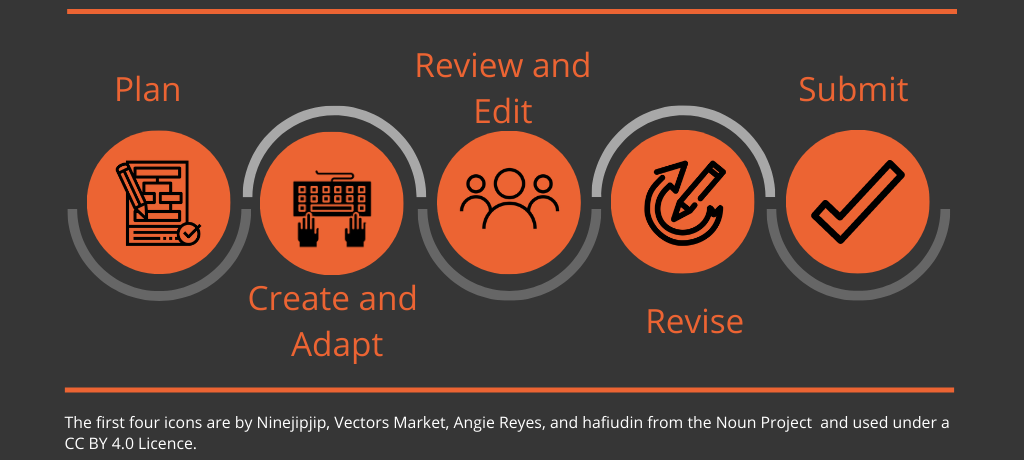1 Workflow and Responsibilities

When creating or adapting a new OER, you will go through five general phases:
- Make a plan.
- Create and adapt content.
- Have the work reviewed and edited.
- Make any necessary revisions.
- Publish and share widely.
This section provides an overview of each of those phases, the specific things you as the author/project lead are responsible for, and the resources available to help you.
Plan
Find collaborators
Identify people who can contribute to the project (including students, staff, and/or subject matter experts) as co-authors, reviewers, editors, instructional designers, etc.
Connect with experts
Connect with the people at your institution who have experience on things like open education, copyright, and instructional design who may be able to help.
Plan your resource
Identify what content you have and what you will need. This can include text, images, videos, etc.
Create or Adapt
Set up your Pressbook
If applicable, set the resource up in Pressbooks. Determine the resource’s structure, elements, and general style guidelines.
- What is the structure of the resource? What is the structure of each chapter? What are consistent elements that will be included throughout the book? For example, glossary terms, videos, learning objectives, exercises questions.
- See the section on Pressbooks in this resource and “Plan Your Book” in the Self-Publishing Guide.
- For recommended style guidelines, see the “Appearance and Design” section in the BCcampus Publishing Style Guide. These are the guidelines the production team will follow.
Find/create open content
Find and/or create content that is open (i.e., learning objectives, text, images, video/audio, glossary terms, H5P activities, exercises).
Ensure diversity and inclusion
Ensure all content reflects the human diversity of our world in a way that is inclusive and respectful.
Track source information
Track licence and source info for all non-original content. This will be used to provide attribution statements for reused and adapted work.
Select/create media
Select/create video, audio, and images that are accessible.
Review, Edit, Revise
Edit your own work
Edit your own work for errors and inconsistencies. Ensure language is clear.
Set up peer review
Bring in people to give feedback on the work.
Incorporate feedback
Incorporate revisions and edits identified by reviewers and editors.
Have work copyedited
Have the resource copy edited and proofread by someone who is not the author. There should be no changes to the content after this point.
Final Steps
Set up book cover and metadata
Select an official title for the resource, have a cover created, and write a short description of the resource. Ensure all metadata for the book is filled out, including the licence, authors, contributors, publish date.
Share publicly
Share your book with the world!
Media Attributions
- OER Creation Process graphic by Josie Gray was created in Canva, and as such it cannot be openly licensed. It includes four icons from the Noun Project:
- Planning by Ninejipjip is licensed under a CC BY 4.0 licence.
- Typing by Vectors Market is licensed under a CC BY 4.0 licence.
- Group by Angie Reyes is licensed under a CC BY 4.0 licence.
- Review by hafiudin is licensed under a CC BY 4.0 licence

